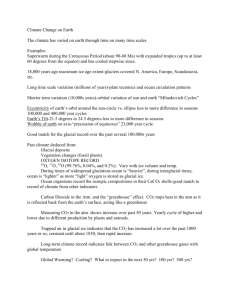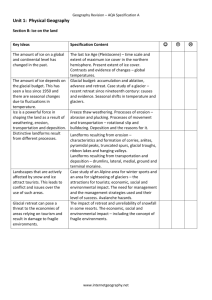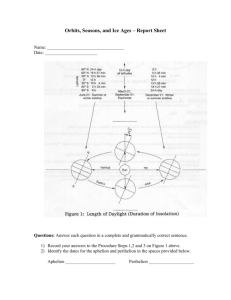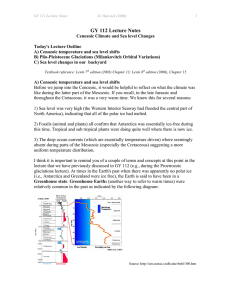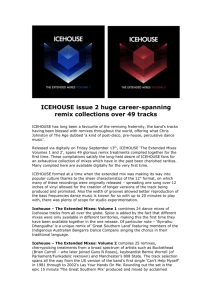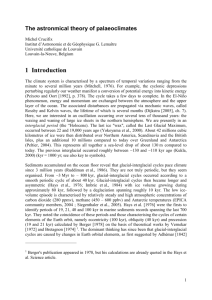Weather is the daily status of the atmosphere
advertisement
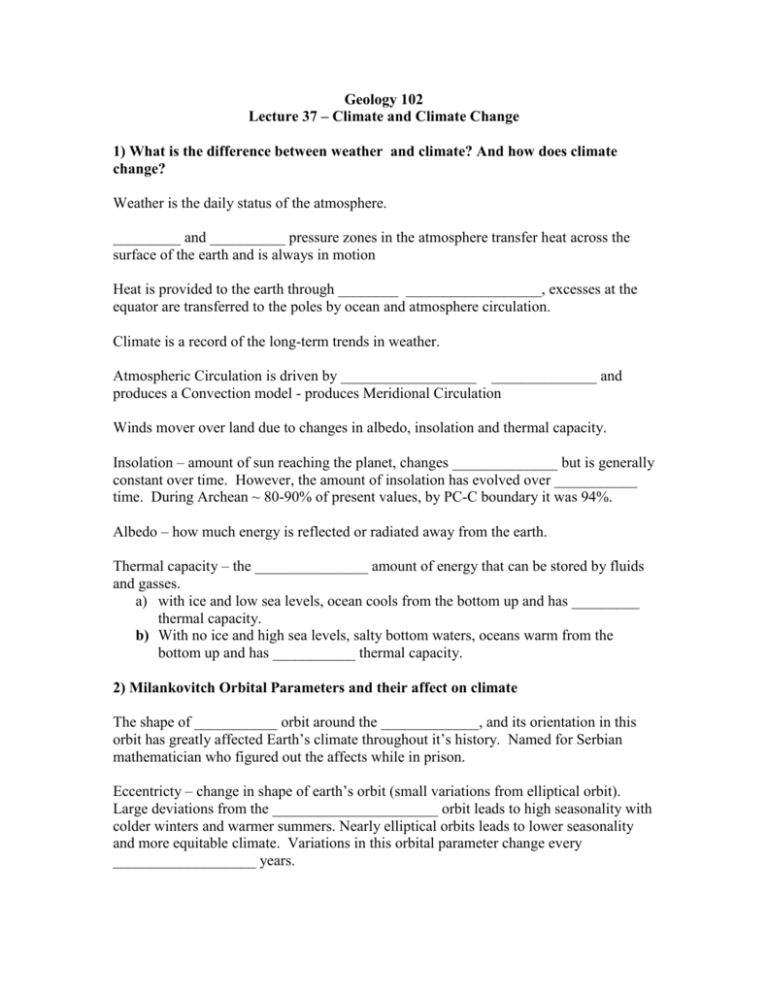
Geology 102 Lecture 37 – Climate and Climate Change 1) What is the difference between weather and climate? And how does climate change? Weather is the daily status of the atmosphere. _________ and __________ pressure zones in the atmosphere transfer heat across the surface of the earth and is always in motion Heat is provided to the earth through ________ __________________, excesses at the equator are transferred to the poles by ocean and atmosphere circulation. Climate is a record of the long-term trends in weather. Atmospheric Circulation is driven by __________________ ______________ and produces a Convection model - produces Meridional Circulation Winds mover over land due to changes in albedo, insolation and thermal capacity. Insolation – amount of sun reaching the planet, changes ______________ but is generally constant over time. However, the amount of insolation has evolved over ___________ time. During Archean ~ 80-90% of present values, by PC-C boundary it was 94%. Albedo – how much energy is reflected or radiated away from the earth. Thermal capacity – the _______________ amount of energy that can be stored by fluids and gasses. a) with ice and low sea levels, ocean cools from the bottom up and has _________ thermal capacity. b) With no ice and high sea levels, salty bottom waters, oceans warm from the bottom up and has ___________ thermal capacity. 2) Milankovitch Orbital Parameters and their affect on climate The shape of ___________ orbit around the _____________, and its orientation in this orbit has greatly affected Earth’s climate throughout it’s history. Named for Serbian mathematician who figured out the affects while in prison. Eccentricty – change in shape of earth’s orbit (small variations from elliptical orbit). Large deviations from the ______________________ orbit leads to high seasonality with colder winters and warmer summers. Nearly elliptical orbits leads to lower seasonality and more equitable climate. Variations in this orbital parameter change every ___________________ years. Obliquity – change in the tilt of the earth within its orbit (varies from 21-24). This parameter affects the distribution of heat between the hemispheres and changes ~ every ___________________ years. Precession – change in the earth’s seasons that occurs every ________________ to ________________ years. 3) Ancient Climate Indicators Coal – ________________________________ climate ____________ Sandstones – _________________________________ climate Carbonates – ___________________________, warm climate, warm waters Red Beds – ________________________ climate Bauxites/Laterites – soils that formed in _____________________ climate Evaporites – _____________ climate _____________ Indicators: till, dropstones, glacial landforms, ____________ climate 4) Icehouse, Greenhouse and Transitional Climate Periods Global Climate is subdivided into Icehouse, Greenhouse and Transitional Periods Icehouse Periods are marked by __________________________; large, rapid _____ ______________ _________________ (40-100 m); low atmospheric _________ contents Transitional Periods are marked by intermediate to small ice caps; ___________________ _____ _________ __________________________ (10-40 m); intermediate ________ content __________________ Periods are marked by no permanent ice caps; ____________ sea level fluctuations, ____________ atmospheric _______ content Most of earth’s climate record is marked by greenhouse periods. Icehouse periods occur at 2.2 Ga, 680-570 Ma (Snowball Earth), 440 Ma, 320-270 Ma, 45 Ma to current. The initiation of the _______________-Antarctic current ~ 45 Ma ushered in our current glacial period. Prior to this event global climate was warmer and more equable. This glaciation intensified about 2 million years ago. Climate change during this period is recorded in oxygen isotope records from deep sea sediment cores and ice cores on land. During glacial periods the isotopically light oxygen is preferentially retained in the ice, making the oceans “heavier”, whereas when there is no ice the oceans are “lighter”. Dust and ice rafting events indicate global temperatures changed up to 2C in less than 10 years!! Terrestrial Evidence for Pleistocene Glaciation 1. ____________________ and other glacial depositional features, also eolian deposits 2. Changes in vegetation 3. Large Lakes The glacial ice that covered North America was up to _____ miles thick at its maximum and took more than _________________ years to melt. Large lakes also formed throughout the western US and their remnants are all that is left. 5) Current and Future Climate Anthropogenic input has likely changed climate. ______, _________, _________, and SO4 all show rapid, abrupt increases in the last 1000 years. All of these increase surface temperatures and are at their highest levels of the last ______________ years it is unclear if this is out of their natural variation limits. ____________ is linked to climate change by increasing the greenhouse gases in the atmosphere which hold in more heat. The CO2 levels recorded in the last 100 years are at their highest level in the last 400,000 years and possibly the last 20-30 million years. The temperature rise since the late 1800’s is unprecedented in the last 1000 years, however, whether this is outside the realm of natural variaitions is unclear. Models for global climate in the next 100 years indicate CO2 and SO2 emissions will continue to rise, which may to lead to an increase in global temperatures of _________C. This may be _______ as much as the natural variations during the last ______________ years. This amount of temperature increase may lead to a sea level rise of _____________ m. Complete melting of the current ice sheets would raise sea level _________________ m which would affect 2/3 of the world’s population. What will (can) we do to stop (resist) climate change? Should we do anything?
